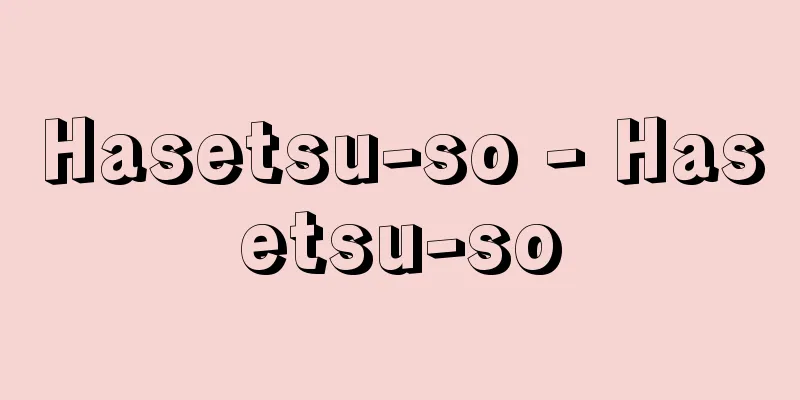Literature - bungaku (English spelling) literature English

|
The simplest explanation of literature is that it is art through language, "linguistic art" (so-called Wortkunst by German aestheticians). Art, in its simplest definition, is a work of figurative expression. Image is originally a word made up of the words katachi (shape) and sugata (image), and refers to something expressed as an image of an individual, concrete form. Literature is the process of carrying out this kind of figurative expression through language. [Hideo Odagiri] The meaning of the word literatureHowever, the word literature is used in quite different senses in the Chinese and Japanese classics. For example, Otsuki Fumihiko's Daigenkai (Great Genkai) explains the meanings of literature in (1) to (4): (1) "the art of studying and studying books" in the Analects, etc., "that is, the study of classics, history, poetry, etc." (2) "the study of language, rhetoric, logic, history, etc., other than the natural sciences, politics, economics, law, etc." (This is the meaning of "literature" when referring to the Faculty of Letters at universities today). (3) In the Taiho Code, it was placed in the household of Prince Uhon and "the position of lecturing on Buddhist scriptures." (4) It is not until "the title given to Confucian scholars in various feudal domains during the Tokugawa period." (5) that the explanation appears: "(Translation of the English word Literature) An aesthetic work that expresses people's thoughts and feelings through writing and that primarily appeals to people's emotions. That is, poetry, novels, plays, literary criticism, history, and the like." It was around 1887 (Meiji 20) that the word literature began to be used in the sense of (5). To put it the other way around, the word literature in the sense we use it today did not exist until that time, which corresponds to the fact that such a concept itself (the concept of literature; not the individual concepts of waka, haikai, gesaku, etc., but the concept of literature as a whole) did not exist in Japan until then. This is worthy of comparison with the fact that literature has long been used in Europe, where "in a broad sense, it encompasses all linguistic products fixed in the form of a document" (explanation of the "literature" entry by Sugino Tadashi in the Encyclopedia of Aesthetics edited by Takeuchi Toshio), and eventually "in the narrow sense, it is applied to those among these that possess aesthetic qualities in particular" (ibid.). The reason why this narrower definition is sometimes called "schöne Literatur, belles lettres," or beautiful literature, is because the broader definition has not yet disappeared. Furthermore, this "aesthetic quality" can be broadly divided into two categories. One category refers to works that are originally outside the realm of literature and have an aesthetic effect or are interesting as concrete human expressions, such as philosophical or historical works, scriptures (such as the Bible), speeches, lectures, sermons, as well as biographies, diaries, letters, travelogues, reportage, essays, aphorisms, etc. The other category refers to works of literature in the true sense, and is called "schöpferische Literatur, creative literature." These include lyric poems, epic poems, novels, plays, and literary criticism. [Hideo Odagiri] Literary ExpressionsLiterature is figurative expression "through language," not limited to figurative expression "through letters." The use of letters as a means of expression only came much later, after letters had finally begun to be widely used. The origins of literature date back to ancient times, when human beings first began to use language expressively (figuratively; for example, when praying to a god, people would express themselves concretely to move the god's heart). Since then, literature was an oral tradition for a very long time, and it is only in the past 5,000 years, since the Sumerian "The Tale of Gilgamesh," that literary expression in writing has taken place. In Japan, it has been around since the "Kojiki" (Records of Ancient Matters) some 1,200 years ago. Incidentally, literary expression through the written word has made a great advance and popularized with the spread of modern printing, and nowadays, when we talk about literature, it is normal to think of it in printed form. In recent years, the spread of radio and television has given rise to new forms of language art, such as recited poetry, radio dramas, television novels, and documentaries, which no longer rely directly on the written word but speak through sound and image, and technological developments in electronics may open up the possibility of even newer means of expression. At present, however, literature in the form of printed words remains the dominant form. [Hideo Odagiri] Literary contentLiterature depicts the relationship between humans and situations from the perspective of humans, but it always captures or depicts individual, concrete humans in a tense relationship with individual, concrete situations, and expresses the deep universal truth of humanity and the essence of the situation through the particular image that it holds. Literary expression is stimulated or energized by living human individuals who, at a certain point, acutely perceive and suffer or resist the social frameworks, various orders, and situations in general that are always moving toward fixity and stability, as contradictions, by feeling suffocated or finding them unbearable and painful. While literature clings to the image of the particular, it seeks to grasp the universal through it, and to realize the disclosure of universal humanity in the concreteness of the individual that is persisted in for the sake of expression. This is related to a fundamental demand that arises from the very condition of life in which human beings, each with different personalities and situations, live together in this world. Along with the usefulness and joy in human cognition of getting to know others and their situations intimately, the heart can be cleansed and elevated by coming into contact with the deep truth of humanity that is revealed in the conflict with circumstances (what Aristotle called catharsis, or purification). Literature is indeed one of the ideologies of a particular era or class in the sense that it is an attempt by humans, who are historical and social beings, to express something using humans from history and the present day as material, but at the same time, somewhat similar to the case of language, it continues to live beyond history and class. This is because, by always depicting the situation from the perspective of living individuals, even if each situation is different, new aspects of the universality of humanity are always expressed, and in this way the eternity of excellent literature is possible. [Hideo Odagiri] "Poetics" by Aristotle, translated by Matsuura Yoshikazu (Iwanami Bunko)" ▽ "Introduction to Literature, first edition, by Homma Hisao (1926, Tokyodo Publishing)" ▽ "What is Literature?" by Sartre, translated by Kato Shuichi (1947, Jinbun Shoin)" ▽ "Introduction to Literature" by Odagiri Hideo (1972, Keiso Shobo) [Reference] |Source: Shogakukan Encyclopedia Nipponica About Encyclopedia Nipponica Information | Legend |
|
文学についてのもっとも簡単な説明は、言語による芸術、「言語芸術」(ドイツの美学者たちの、いわゆるWortkunst)ということである。芸術とは、これももっとも簡単な定義では、形象的表現による作品、である。形象は、もともと形(けい)(かたち)と象(しょう)(すがた)を組み合わせてなったことばだが、個別的・具体的なすがたかたちのイメージとして表現されたものをいう。このような形象的表現を言語によって行うのが文学である。 [小田切秀雄] 文学ということばの意味ただし、文学ということばは、中国および日本の古典ではかなり違った意味で用いられていて、たとえば大槻文彦(おおつきふみひこ)の『大言海』は文学の語義の(1)~(4)をそれらの説明にあてている。(1)『論語』等での、「書ヲ読ミテ講究スル学芸。」「即チ、経史、詩文等ノ学。」(2)自然科学や政治、経済、法律等の諸学以外の、「語学、修辞学、論理学、史学、等ノ一類ノ学」(現在、大学の文学部という場合の「文学」はこの意味)。(3)大宝令(たいほうりょう)で有品(うほん)親王の家に置き、「経ヲ講ゼシメシ職。」(4)「徳川時代、諸藩儒員ノ称。」(5)に至って初めて、「[英語、Literatureノ訳語]人ノ思想、感情ヲ、文章ニヨリテ表現シ、人ノ感情ニ訴フルヲ主トセル美的作品。即チ、詩歌、小説、戯曲、又、文学批評、歴史ナドノ類ナリ。」という説明が出てくる。 文学ということばが、この(5)のような意味で用いられるようになったのは、1887年(明治20)前後からである。これを逆にいえば、現在用いられるような意味での文学ということばはその時期まではなかったのであり、このことは、それまでの日本にはそういう概念そのもの(文学概念。和歌、俳諧(はいかい)、戯作(げさく)等の個別の概念でなく、それらをひっくるめての文学という概念)が存在しなかったことに対応している。これはヨーロッパでも長くliteratureが、「広義においては文書の形式に固定されたすべての言語的所産を包括」(竹内敏雄編『美学事典』の杉野正による「文学」の項の説明)し、やがて「狭義においてはこのうち特に美的品質をそなえたものに適用される」(同上)ようになっているのと、比較検討されるに値する。 この狭義のほうをschöne Literatur, belles lettresつまり美文学として区別する場合があるのは、なお広義の用法がまったくなくなったわけではないことに関連している。また、この「美的品質をそなえた」ものが、大きくいって二つに分かれる。一つは、本来、文学以外の領域に属するもので美的な効果ないし具体的な人間の表現のおもしろさを備えたもの、すなわち哲学的ないし歴史的な著作、経典(聖書などの)、演説、講演、説教、また伝記、日記、書簡、紀行、ルポルタージュ、エッセイ、アフォリズム等々をいう。もう一つのほうが本来の文学作品で、創造的文学schöpferische Literatur, creative literatureといわれている。叙情詩、叙事詩、小説、戯曲、文芸評論等のことである。 [小田切秀雄] 文学の表現文学は「言語による」形象的表現で、「文字による」形象的表現に限られていない。表現の手段として文字が用いられるようになったのはずっと下った時代、ようやく文字が広く使われ始めてからのことである。 文学の起源は、人類があるときから言語を表現的に(形象的に。たとえば、神に祈るときに、その神の心を動かすように具体的に表現する)使うようになった遠い原始の時代にさかのぼる。以来、文学は実に長い期間にわたって口誦(こうしょう)・口承の文学であり、文字による文学表現が行われるようになったのは、たかだかシュメールの『ギルガメシュ物語』以来の5000年ほどにすぎない。日本では千二百数十年前の『古事記』以来である。 ところで、文字による文学表現は、近代の印刷術の普及によって画期的な発展・大衆化をつくりだし、いまでは文学というと印刷された形のものが普通になっている。最近ではまた、ラジオ、テレビの普及に伴って朗読詩や放送劇やテレビ小説やドキュメンタリーなど――もはや直接には文字に頼らずに、音声と映像とで語りかけてくる新たな言語芸術が成立してきており、電子工学の技術的な発展はさらに新たな表現手段の可能性を開くかもしれない。しかし現在のところでは、印刷による文字の文学が支配的な形になっている。 [小田切秀雄] 文学の内容文学は、人間と状況との関係を人間の側から描くが、つねに個別的・具体的な人間の側から、個別的・具体的な状況との緊張した関係においてとらえまたは描き、固執されたその個別の形象を通して人間性の深い普遍的な真実と状況の本質を表現する。つねに固定に向かい安定しようとする社会の枠組み、種々の秩序、総じて状況に対して、あるときからそれを息苦しく感じる、耐えがたくつらく思う、という形で矛盾として鋭敏に受け止めて苦しみまたは抵抗する生身の人間個人が、文学的表現を促し、または活気づける。文学が個別の形象に執しながら、それを通して普遍をとらえ、表現のために固執される個人の具体性において普遍的な人間性の開示を実現しようとする、ということは、それぞれに違った個性と状況とをもった人間が、ともにこの世界で生きていくという生活条件そのものに発した根源的な要求にかかわり、他人のこととその状況を立ち入って知るという人間認識上の有用性と喜びとともに、状況との葛藤(かっとう)において現れる人間性の深い真実に触れて心が洗われ高められる(アリストテレスのいわゆるカタルシス=浄化)ということがある。 文学は、歴史的・社会的存在である人間が、歴史や現代においての人間を素材にして、何事かを表現しようとしたものだという意味では、まさに特定の時代・階級のイデオロギーの一つであるが、それと同時に、言語の場合といくらか相似て、歴史や階級を超えて生命を保ち続けるということがある。状況はそれぞれに違ってもつねに生身の個人の側から描くということを通して、人間性の普遍のつねに新たな局面が表現されるためで、優れた文学の永遠性はこのようにして可能になる。 [小田切秀雄] 『アリストテレス著、松浦嘉一訳『詩学』(岩波文庫)』▽『本間久雄著『文学概論』初版(1926・東京堂出版)』▽『サルトル著、加藤周一訳『文学とは何か』(1947・人文書院)』▽『小田切秀雄著『文学概論』(1972・勁草書房)』 [参照項目] |出典 小学館 日本大百科全書(ニッポニカ)日本大百科全書(ニッポニカ)について 情報 | 凡例 |
>>: Cultural science (English: Kulturwissenschaft) German
Recommend
Hanbok - Kangfuk
The name of Korean clothing in Korea. Kanpuku. Han...
Cowpox virus
...It is well known that Jenner developed the vac...
Halothane
Also called fluothane. CF 3 CHClBr. Non-flammable,...
collegium musicum
...In the 17th century, music from Italy, France,...
Petrovich Avvakum
1620‐82 A 17th-century Russian archpriest. A leade...
Voyage - Koukai
〘 noun 〙 To cross the sea by boat. To navigate the...
Academy of Sciences
[1] The abbreviation for the Imperial Academy, or ...
Flower leaf - Kayo (English spelling)
A flower is thought to be a branch that has been s...
Nucleoprotamine
... refers to a complex formed in a cell by the b...
Kammerer, P. - Kammerer
…After WL Johansen proposed the pure line theory ...
Gemistos, G. (English spelling) GemistosG
…Byzantine Neoplatonist philosopher. His real nam...
cekk
…In this way, the bill of exchange became a disco...
Syphilis, Lues
[What kind of disease is it?] This disease is caus...
Kyogen actor
An actor who performs kyogen (hon kyogen, ai kyog...
Volcanic activity
Volcanic activity is a phenomenon in which magma e...









